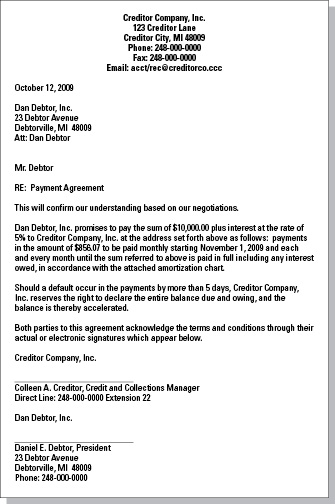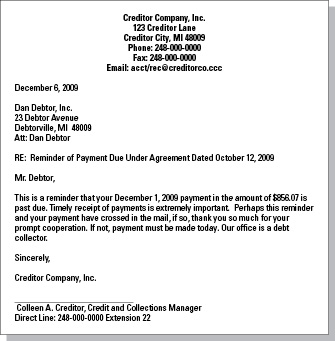Chapter 10
Closing the Deal: Wrap It Up in Writing
In This Chapter
Confirming agreements for payment in writing
Drafting a short but mighty agreement
Reminding your debtor to pay up
Memory can be very convenient. You probably aren’t surprised when a debtor not only “forgets” to make a first payment, but also “forgets” the amount of that payment and the date it’s due. After all, it’s to the debtor’s advantage to suffer shortness of memory when it comes to promised payments, particularly when the debtor is struggling with cash flow problems and wants to conserve its cash.
They say that promises are meant to be broken, and that’s particularly true of oral ones. After a promise is in writing, however, the rules change, because the written word is more difficult to “forget” than the spoken word, and a faxed copy of your agreement quickly overcomes the objection, “That’s not how I remember it.” That’s one of the reasons we stick to the mantra, “It just isn’t done if it’s not in writing.”
After you have an agreement with a debtor, you should wrap up your deals and payment plans by putting them in writing. It takes very little extra work and can really pay off for you. This chapter guides you through the process of getting your agreements down in writing, with tips on getting your debtor to confirm the written agreement.
Creating and Completing a Written Agreement
From the day your customer becomes your debtor, you’re looking at a history of broken promises. You’ve now negotiated the resolution of its unpaid balance, but what makes this promise any different from what you’ve heard before? Even with the debtor’s renewed commitment to pay off the debt, a part of you knows that there’s a big chance that your debtor will again default in making payments. Having gone through all the work of negotiating an agreement, you may still end up having to file a collection lawsuit and drag the debtor into court.
So your goal is not only to get the new payment agreement down in writing, but also to have a clear document signed by the debtor admitting the balance owed and confirming the promise to pay it off.
Having reached this point in collections, if the debtor defaults yet again, you’re not going to start over. You’re going to court. Why all this emphasis on getting a payment agreement in writing if you’re planning to sue the debtor if a default occurs? Because the fastest way to obtain a judgment against your debtor is to show the court your debtor’s written admission of the balance due and its promise to pay off the acknowledged debt. For more on admissions and their use in court, see Chapter 9.
Even after three decades of collecting debts, I can assure you that it’s still a thrill to hear the judge declare, “Based on what I’ve seen, including written admissions of the debt, it sure seems like the debtor owes the money.” That’s why it’s important to put agreements into writing. The document can help inspire payment should the debtor’s memory become short, and the document makes it more likely that a court will rule in your favor if you have to sue to recover your money.
In this section, we show you how to create a written agreement to pay off the debt while avoiding any pitfalls of possibly saying the wrong thing.
If you agree on the phone that your debtor is to pay $250 per month on a debt, but you type up your written confirmation with the requirement that he pays $100 per month, you’ll generally be stuck with the $100 payments instead of $250.
If you have a prior promissory note secured by a mortgage that allows for interest, attorney fees, foreclosure rights, and the like, you must take care that any new promissory note or written agreement doesn’t wipe out your remedies under the original note.
When you already have a written agreement to pay off a debt, because of the possibility that a new agreement may weaken your ability to collect the debt, seek professional advice before entering into a new written agreement.
Composing a letter or e-mail to your debtor
When you write to your debtor, your primary goal is to motivate him to commit to repayment in writing. Reaching an oral agreement is the hardest part of the collections battle, but if you don’t get it in writing, you’ll quickly realize that your victory was only partial. You want to deprive your debtor of any wiggle room by having the terms of the deal set in stone.
Immediately after the deal is struck, set the stage for written confirmation. Without any hesitation, and while your debtor is still on the phone, say, “Okay then, we have our deal. I’m sending you an e-mail right now to confirm the details. What’s your e-mail address? Do you have it yet? Reply by typing ‘I agree’ and type your name below.” Simple enough, eh?
This confirms our agreement made today, [today’s date], whereby you will make payments of $____ per month on a balance owed of $____, starting next Monday, [Monday’s date].
If your agreement is for a lump sum settlement, the payment terms are:
[The total amount owed, to the penny] to be paid in a full, lump sum, by or before [exact date] at [name of your company and address where you want the payment made].
When you seek written confirmation, remember:
Electronic signatures are legal and enforceable. When a pen-and-ink signature isn’t possible, you can enter into binding agreements through e-mail or by other electronic means.
Speed is key. Use fast methods of delivery, such as an e-mail or fax, so you find out right away — ideally before you’re off the phone, less ideally within the hour — if the debtor is truly motivated to agree in writing to the terms you just negotiated.
Figure 10-1: An agreement for payment.

Figure 10-2: An amortization schedule.

Using a promissory note to confirm a deal
A promissory note is a formal contract for payment, typically reciting the balance due, amount of each monthly payment, interest rate, first payment date, last payment date, and possibly providing for late fees. Although a simple payment agreement as we describe earlier in this chapter usually works as well as a promissory note, if you don’t trust the debtor, you anticipate the need for litigation, or your gut instincts tell you that you could have trouble collecting, you may prefer the formality of a promissory note.
Promissory notes are widely understood and accepted. They can be linked to any personal guaranties that you may have negotiated. If you’re taking a lien on property, you should also execute a mortgage or security agreement as part of the agreement.
Getting the Payment Plan Underway: That All-Important First Installment
Why is it that the very first installment payment is always the most important one? All the time and effort you put into negotiating a settlement of your account is at stake, and getting the agreed payment in a timely fashion establishes whether your debtor intends to start playing by the rules. If he fails the test, you need to consider litigation, as we describe in Chapter 15.
For best results, fax or e-mail your first (polite) reminder before payment is due.
Figure 10-3: A reminder letter.

